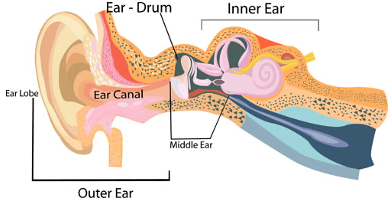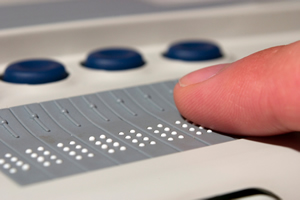Auditory Disabilities
Types of Auditory Disabilities
Types of Auditory Disabilities
With a better understanding of auditory disabilities, web authors will have an increased appreciation for individuals with these disabilities, and an increased commitment to provide accessible content.
The word "disabilities" in the title of this section is controversial. Those who are deaf or hard-of-hearing often don’t view their deafness as a disability. Still, we have retained the word "disability" in this section, not to provoke controversy, but to underscore the fact that those who are deaf cannot hear audio content, and this is the critical point for web developers to remember.
Although some individuals are completely deaf, many individuals with hearing loss still have some degree of hearing. Individuals with mild or moderate hearing loss are often referred to as "hard-of-hearing," whereas "deaf" usually refers to individuals with severe or profound hearing loss. Additionally, hearing impairments include a variety of hearing difficulties; it’s not just about the volume of the perceived sounds.
Causes of Hearing Loss
 The ear can be divided into three main sections: the outer ear, the middle ear, and the inner ear. Sound moves through the outer ear and hits the ear drum (part of the middle ear). This vibrates to produce mechanical energy, which is transferred through tiny bones in the middle ear (called ossicles) to the inner ear where it is converted to electrical impulses. These impulses are sent through the auditory nerve to the brain for processing. Damage to any of these can result in some form of hearing loss.
The ear can be divided into three main sections: the outer ear, the middle ear, and the inner ear. Sound moves through the outer ear and hits the ear drum (part of the middle ear). This vibrates to produce mechanical energy, which is transferred through tiny bones in the middle ear (called ossicles) to the inner ear where it is converted to electrical impulses. These impulses are sent through the auditory nerve to the brain for processing. Damage to any of these can result in some form of hearing loss.
Hearing loss often occurs early in life due to genetic or developmental causes. It can also occur as a result of middle ear infections, traumatic injury, or diseases. Hearing often degrades with age.
Degrees of Hearing Loss
- Mild hearing loss:
- Individuals may have some difficulty understanding normal speech, especially with background noise.
- Moderate hearing loss:
- Individuals may have difficulty understanding most normal speech even with no background noise. A hearing aid may be required.
- Severe hearing loss:
- Individuals may have difficulty understanding even loud speech and will not perceive most noises. Some individuals with severe hearing loss communicate principally through sign language; others rely on lip-reading techniques. Hearing aids are often insufficient.
- Profound hearing loss:
- Even loud speech and noises will not be perceived by individuals with profound hearing loss. Many individuals with profound hearing loss communicate principally through sign language; others rely on lip-reading techniques.
Categories of Hearing Loss
The types of hearing loss can be sorted into a four categories: conductive, sensorineural, auditory processing, or mixed.
Sensorineural hearing loss occurs in the inner ear. The sounds may reach the inner ear correctly, but the nerves do not send the information to the brain properly. This accounts for about 90% of reported hearing loss.
Conductive hearing loss is caused by something that prevents sounds from reaching or being conducted properly by the inner ear, such as a blockage or damage to the ear. Disease or injury can cause damage to the outer or middle ear, which can prevent proper detection of sounds.
Auditory processing hearing loss involves the incorrect processing of the electrical signals in the brain. In other words, the person can hear the sound, but they can’t understand it. This means an individual will not understand spoken language, even if they are able to hear it correctly.
Mixed hearing loss is a combination of both conductive and sensorineural hearing loss.
Individuals with hearing loss in these various categories may be impacted in various ways:
High frequency hearing loss is the loss of the ability to hear high tones and pitches. It may be more difficult to hear the voice of a woman or young child, for example.
Low frequency hearing loss is the inability to hear low tones and pitches. This can make it difficult to understand low voices.
Hyperacusis is an extreme sensitivity to specific frequencies and volume ranges. Some pitches that sound normal to most people will become extremely loud or even painful to individuals with hyperacusis.
Tinnitus describes phantom noises which are heard by the individual but are not caused by any external sound. It is often described as a ringing or hissing noise. For some individuals, this can be permanent and even debilitating.
 Deaf-blindness is the condition of being both deaf and blind. These individuals often communicate using sign language by placing the hand of the other person in theirs and feeling the sign. When accessing web content, they generally use Braille devices that allow them to access the textual content of the web page, including alternative text for images.
Deaf-blindness is the condition of being both deaf and blind. These individuals often communicate using sign language by placing the hand of the other person in theirs and feeling the sign. When accessing web content, they generally use Braille devices that allow them to access the textual content of the web page, including alternative text for images.
